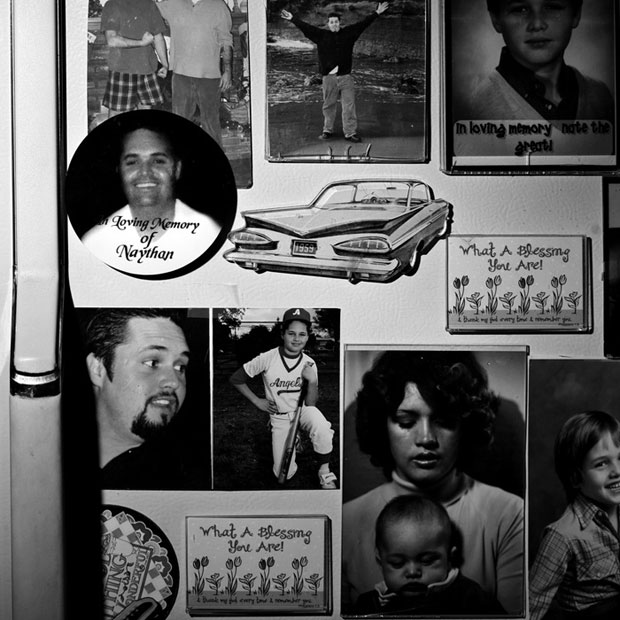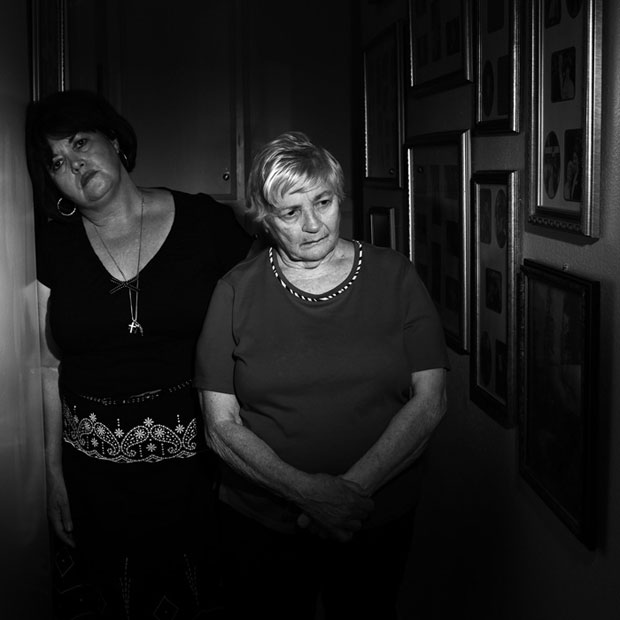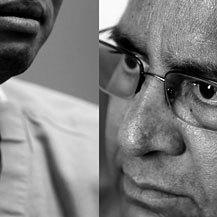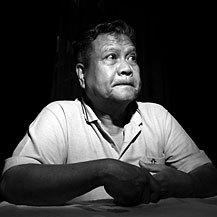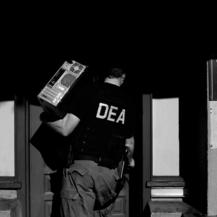Dying for relief | A Times Investigation
Legal drugs, deadly outcomes
November 11, 2012
Prescription overdoses kill more people than heroin and cocaine.
An L.A. Times review of coroners’ records finds that drugs prescribed by a
small number of doctors caused or contributed to a disproportionate number of deaths.
Terry Smith collapsed face-down in a pool of his own vomit.
Lynn Blunt snored loudly as her lungs slowly filled with fluid.
Summer Ann Burdette was midway through a pear when she stopped breathing.
Larry Carmichael knocked over a lamp as he fell to the floor.
Jennifer Thurber was curled up in bed, pale and still, when her father found her.
Karl Finnila sat down on a curb to rest and never got up.
These six people died of drug overdoses within a span of 18 months. But according to coroners' records, that was not all they had in common. Bottles of prescription medications found at the scene of each death bore the name of the same doctor: Van H. Vu.
After Finnila died, coroner's investigators called Vu to learn about his patient's medical history and why he had given him prescriptions for powerful medications, including the painkiller hydrocodone.
Investigators left half a dozen messages. Vu never called back, coroner's records state.
Over the next four years, 10 more of his patients died of overdoses, the records show. In nine of those cases, painkillers Vu had prescribed for them were found at the scene.
Vu, a pain specialist in Huntington Beach, described himself as a conscientious, caring physician. He declined to comment on individual cases, citing confidentiality laws, but he said he treats many "very, very difficult patients" whose chronic pain is sometimes complicated by substance abuse and depression, anxiety or other mental illness.
"Every single day, I try to do the best I can for every single patient," he said in an interview. "I can't control what they do once they leave my office."
Prescription drug overdoses now claim more lives than heroin and cocaine combined, fueling a doubling of drug-related deaths in the United States over the last decade.
Health and law enforcement officials seeking to curb the epidemic have focused on how OxyContin, Vicodin, Xanax and other potent pain and anxiety medications are obtained illegally, such as through pharmacy robberies or when teenagers raid their parents' medicine cabinets. Authorities have failed to recognize how often people overdose on medications prescribed for them by their doctors.
A Los Angeles Times investigation has found that in nearly half of the accidental deaths from prescription drugs in four Southern California counties, the deceased had a doctor's prescription for at least one drug that caused or contributed to the death.
Reporters identified a total of 3,733 deaths from prescription drugs from 2006 through 2011 in Los Angeles, Orange, Ventura and San Diego counties.
Dr. Van H. Vu said of his patients: “I can't control what they do once they leave my office.” (Liz O. Baylen / Los Angeles Times)
An examination of coroners' records found that:
- In 1,762 of those cases — 47% — drugs for which the deceased had a prescription were the sole cause or a contributing cause of death.
- A small cadre of doctors was associated with a disproportionate number of those fatal overdoses. Seventy-one — 0.1% of all practicing doctors in the four counties — wrote prescriptions for drugs that caused or contributed to 298 deaths. That is 17% of the total linked to doctors' prescriptions.
- Each of those 71 physicians prescribed drugs to three or more patients who died.
- Four of the doctors — including Vu — had 10 or more patients who fatally overdosed.
- Vu had the highest total: 16.
Experts said the findings challenge the prevailing view of what is driving the surge in overdose deaths and should prompt closer scrutiny of doctors and their prescribing practices.
"The data you have is something that's going to shock everybody," said Dr. Jorge F. Carreon, a former member of the Medical Board of California.
Carreon, a South Gate physician whose term on the board ended in July, said he had long suspected that doctors' prescriptions were contributing to the increase in overdoses. The Times' analysis, he said, showed that it was "worse than what I thought."
President Obama's drug czar, R. Gil Kerlikowske, said of the findings: "Do I think this has the potential to change the game in the way it's being looked at and being addressed, both at the state and federal level? Yes, I do."
In its review of prescription drug fatalities, The Times examined cause-of-death findings, toxicology reports and other information in county coroners' files, including lists of prescription medications found at death scenes. Those lists typically identify the prescribing doctor.
The deaths often stemmed from multiple drugs, sometimes prescribed by more than one physician. In some cases, the deceased mixed alcohol or illicit drugs with prescription medications.
Medical experts say that even one overdose death should prompt a doctor to conduct a thorough review of his or her prescribing.
"Personally, it would be a big, big deal," said Dr. Peter Przekop, a pain and addiction specialist at the Betty Ford Center in Rancho Mirage and an assistant professor at Loma Linda University School of Medicine. "I would certainly want to stop using those medications until I knew what was going on."

Risky path to relief Three pain doctors talk about treatment »
The 71 doctors with three or more fatal overdoses among their patients are primarily pain specialists, general practitioners and psychiatrists. Almost all work alone, without the peer scrutiny that is standard in hospitals, group practices and HMOs.
Four of them have been convicted of drug offenses in connection with their prescriptions. A fifth is awaiting trial on charges of second-degree murder in the overdose deaths of three patients.
The rest have never faced criminal prosecution over their practice of medicine, and most — including Vu — have spotless records with the Medical Board of California, which licenses and oversees physicians.
Dr. Lynn Webster, president-elect of the American Academy of Pain Medicine, said many physicians lack an appreciation of how easily patients with chronic pain can become addicted to their medications, and how dangerous those drugs can be.
"It leads them down a path that can be very harmful, and that's what physicians have to watch for," said Webster, who practices in Salt Lake City.
He said physicians who prescribe pain medications have a duty to screen patients for risk factors for addiction and then watch them closely to prevent abuse.
In interviews, several of the 71 Southern California doctors with multiple patient deaths described themselves as compassionate caregivers who try to ease the suffering of those in pain.
Vu and others said they follow recommended practices to deter drug abuse, including requiring patients to sign "pain management contracts" in which they agree to take their medications as directed and not obtain more from other doctors.
Some of the 71 doctors said overdose victims caused their own deaths by ignoring instructions on the safe use of medications. Some said family members of the deceased bore responsibility too for failing to intervene. Some also faulted health insurers, saying that reduced payments to physicians have made it difficult to spend the time to monitor patients adequately.
These doctors' 298 patients who died of overdoses ranged in age from 21 to 79. The median age was 48.
Many had histories of mental illness or addiction, including previous overdoses or stints in drug treatment. Others did not start out as high-risk patients. They were middle-aged adults — teachers, nurses and police officers — with bad backs, injured knees and other non-life-threatening conditions.
Lynn Blunt was a 46-year-old mother of four who suffered from degenerative disc disease. Despite the pain, she was careful not to exceed the recommended dosage of her medications, said her husband, Lonnie. She wanted to remain alert enough to care for her two youngest children, girls ages 14 and 11, he said.
The condition eventually crippled Blunt, leaving her dependent on a cane and unable to continue working as a U.S. customs inspector. She saw a series of doctors, eventually ending up at Vu's California Pain Center.
According to coroner's records, Vu prescribed skin patches containing fentanyl, a pain reliever 100 times more powerful than morphine.
On Sept. 7, 2006, coroner's records show, Blunt went to Vu's clinic to receive an epidural injection of an unspecified medication for her pain. A day later, she was found dead in her family's apartment in Downey.
Blunt overdosed on multiple drugs prescribed by Vu and two other doctors, coroner's records show. High levels of fentanyl were found in her system.
Blunt had been looking forward to a planned trip to the East Coast to visit one of her two grown children, her husband said.
"We followed the prescriptions," he said. "Something didn't mix well."
Vu, a native of Vietnam, was 11 when he and his family immigrated to the U.S. as refugees just before the fall of Saigon in 1975. They settled in Seattle.
As a high school student, he volunteered at a clinic for low-income families and was impressed, he said, by the selflessness of physicians serving "people who really needed help."
He earned undergraduate and medical degrees from the University of Washington and served a residency in anesthesiology at USC. He is board-certified in that field and in pain medicine.
"I pretty much achieved the dream come true that America affords," said Vu, 49, who lives with his wife and four children on Christiana Bay in Huntington Beach.
Vu said most of his patients are referred by other doctors, who turn to him as "a last resort" for those who have been battling pain for years. Many patients come to him already dependent on narcotics, he said.
Vu said he conducts routine urine tests to make sure they take their medications as prescribed and do not use illegal drugs. He said he regularly uses a state-run prescription monitoring program to see whether any of his patients are also obtaining drugs from other doctors.
"I am doing the best I can in this very difficult field," he said. "I consider myself to be one of the best. But we have limits."
He said any patient death from an overdose was unacceptable, but added that he has treated thousands of patients successfully with the same drugs.
"Are we willing to trade that?" he asked. "Are we willing to withhold pain medications from everyone?"
Vu said he was unaware of many of his patients' deaths until Times reporters contacted him. He called the information "eye-opening."
"I'm a physician," Vu said. "I feel terrible when somebody loses their life. I'm the one who should be prolonging life, so I'm saddened by that."
Asked whether he could have taken steps to prevent any of the deaths, Vu paused.
"No," he said, finally. "I don't think so."
Larry Carmichael was a problem drinker who got sober through Alcoholics Anonymous. A doting single father, he coached his son's T-ball team and passed on his love of surfing and fishing.
Carmichael worked as a carpet layer until a car accident left him with debilitating back pain, recalled his son, Dan. He went from one doctor to another in search of relief, and eventually became Vu's patient.
By 2007, Carmichael "had a high tolerance and was known to take too many pills for his pain," coroner's records state. Renee Allen, Carmichael's girlfriend, said she encouraged him to see if he could live without the medications, and to find another doctor.
"I'm not going to sit around and watch you die," she recalled telling him.
But Carmichael kept taking pills. In the months before he died, Carmichael twice passed out, his son said.
"He needed real help," Dan said.
On March 7, 2007, Carmichael filled prescriptions from Vu for half a dozen pain and anxiety medications, including morphine, according to coroner's records.
After Carmichael failed to return phone calls for two days, Dan went to his father's apartment in Lake Forest and found him dead. He was 51.
Dan grabbed his father's prescription bottles and smashed them against a wall, sending pills flying around the room, according to a report by a coroner's investigator.
The coroner concluded that Carmichael died of an accidental overdose of morphine.
For decades, prescriptions for narcotic painkillers were limited largely to cancer patients and others with terminal illnesses. The prevailing view was that the risk of addiction outweighed any benefit for the great majority of patients whose conditions were not life-threatening.
Today, narcotic painkillers are among the most popular prescription drugs in the U.S.
The seeds of this turnabout were planted in the late 1980s, when influential physicians argued in medical journals that it was inhumane to ignore suffering in non-cancer patients.
This new perspective coincided with efforts by drug makers to win approval for formulations of narcotics intended to ease moderate pain.
Pharmaceutical companies launched sales campaigns that downplayed the risks of addiction and overdoses and promoted the benefits of pain relief.
In 2001, Congress declared the start of the Decade of Pain Control and Research. Medical boards across the country encouraged physicians to assess and treat pain in all patients. In 2007, California lawmakers expanded the scope of pain relief, making it legal for doctors to prescribe narcotics to addicts, so long as the purpose was to treat pain and not simply feed a habit.
The use of painkillers quadrupled between 1999 and 2010. Doctors write about 300 million prescriptions a year for painkillers. That is enough for every adult American to be medicated around the clock for a month, according to the Centers for Disease Control and Prevention.
Hydrocodone became the most commonly prescribed drug in the U.S., eclipsing the leading antibiotics and cholesterol medications.
Older pain drugs — including morphine, codeine and Dilaudid — found new life outside hospital wards, while new ones such as fentanyl and Opana were brought to market. OxyContin, a chemical cousin of heroin, had sales of more than $1 billion within a few years of its introduction.
Narcotic pain relievers now cause or contribute to nearly 3 out of 4 prescription drug overdoses and about 15,500 deaths each year, according to the CDC. For every death, 32 people are treated in emergency rooms for nonfatal overdoses.
Although the death toll has received considerable attention, the medical board and law enforcement agencies in California have not mined coroners' files, as The Times did, to identify doctors whose patients overdosed on drugs they prescribed.
Nor have officials tried to take advantage of detailed information that pharmacies provide to the state attorney general's office, listing the kinds and quantities of drugs prescribed, by which doctors and for which patients.
The Controlled Substances Utilization Review and Evaluation System was designed to help doctors learn whether any of their patients were seeking drugs from other physicians too.
The system could also be used to identify doctors who write large numbers of prescriptions for commonly abused drugs. The CDC has urged state authorities to use such programs to identify not only doctor-shopping patients but the physicians who cater to them. In California, authorities do neither.
Karl Finnila had a long record of drug arrests by the time he became Vu's patient. He was bipolar, had attempted suicide and had overdosed several times, according to coroner's records and his sister Sally, a tax accountant in Irvine.
Finnila, the oldest son of a Mattel Inc. executive, had been addicted to prescription drugs since he was a teenager, his sister said. He had been in and out of mental hospitals and was unable to hold a job.
He would lose touch with his family. But every so often, Sally would find him, take him to lunch and buy him a new pair of shoes and socks.
On June 29, 2007, Finnila was discharged from a hospital in Orange County, according to Carol Spetzman, a friend and caregiver. He had been treated there for a drug overdose, his sister said.
That same day, he filled prescriptions from Vu for hydrocodone and carisoprodol, a muscle relaxant, at a pharmacy down the hall from the doctor's office, coroner's records show.
Finnila then checked into a sober-living home in Westminster. After dinner, he went for a walk, sat down on a curb and died, coroner's records state.
The cause was "combined effects" of hydrocodone, carisoprodol and seven other medications prescribed by Vu and other doctors. He was 43.
About this story
This is the first in a series of occasional stories on the epidemic of prescription drug deaths. For this article, reporters Lisa Girion and Scott Glover, with help from reporter Hailey Branson-Potts, examined coroners' records and interviewed doctors, regulators, law enforcement officials and relatives of those who died from overdoses.
Doug Smith, The Times' director of computer-assisted reporting, and data analyst Sandra Poindexter created a searchable database on drug deaths in four Southern California counties to identify those tied to doctors' prescriptions.
Times photojournalist Liz O. Baylen created still images and videos, contributed reporting and helped conduct interviews.
Stephanie Ferrell designed the web presentation and Armand Emamdjomeh created the interactivity.
Jennifer Thurber had been coping with pain for much of her life by the time she came under Vu's care.
Thurber's childhood was marred by a painful stomach condition that caused severe indigestion. She had corrective surgery when she was 11, but a car accident seven years later brought the problem back.
She was prescribed various medications for the pain and eventually began abusing them, according to her father, Charles, an Orange County sheriff's deputy.
Thurber obtained drugs through various doctors. On May 21, 2007, she filled prescriptions for morphine and methadone written by Vu.
Two days later, her father climbed the stairs of the family's Fountain Valley home and pushed open the door of her bedroom to ask her to get ready for dinner.
He found his daughter in bed, pale and motionless. Blood trailed from her nose. He laid her on the floor and attempted CPR.
Thurber died of an overdose of multiple drugs prescribed by Vu and two other doctors, coroner's records show.
Morphine and methadone were among the drugs. She was 22.
"That was my birthday," her father recalled, his voice wavering. He said he blames himself for not seeing the signs of drug abuse sooner and for not paying closer attention to her doctors and what they were prescribing.
"At the time," he said, "we thought they were trying to help her."
Times staff writers Hailey Branson-Potts and Anh Do contributed to this report.

